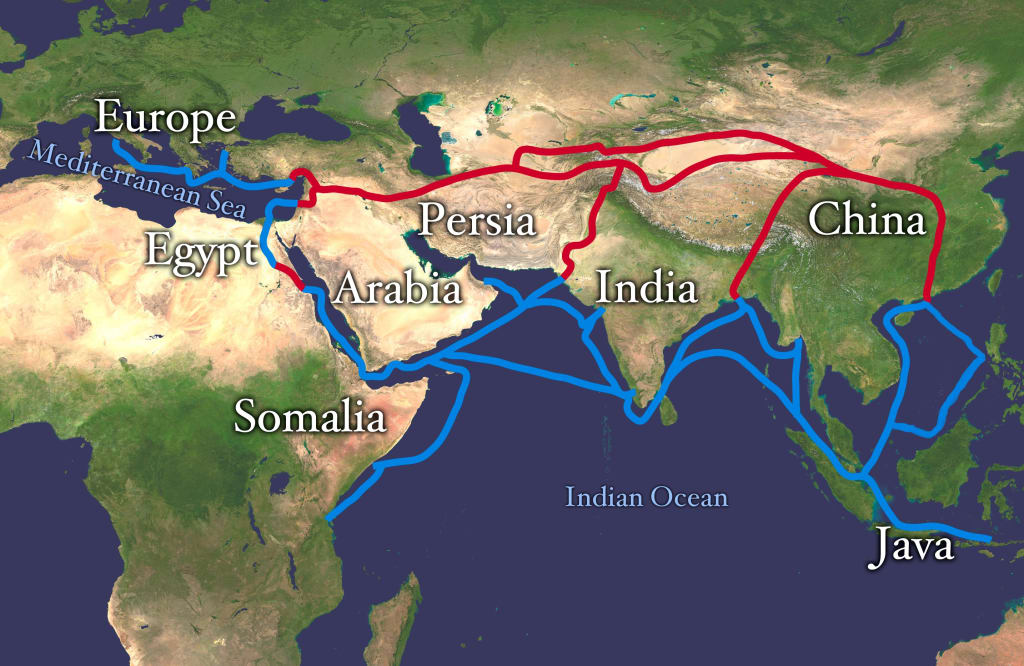"Silk Roads and Sea Voyages: A Tapestry of Ancient Trade"
Threads of Commerce, Culture, and Connection in Ancient Trade Routes

In the vast tapestry of human history, few threads weave together a more intricate and captivating pattern than the ancient trade routes known as the Silk Roads and the maritime voyages that navigated the vast seas. These interconnected networks of commerce, culture, and innovation served as the lifelines of ancient civilizations, fostering a dynamic exchange of goods, ideas, and cultural influences that transcended geographical boundaries.
The Silk Roads, a network of interconnected routes that stretched across Asia, Africa, and Europe, were not merely pathways for the trade of silk but arteries through which civilizations bled into one another. The journey along these routes was a testament to the human spirit of exploration and an insatiable desire for the exotic.
The heart of the Silk Roads lay in Central Asia, where caravans laden with silks, spices, precious metals, and other commodities embarked on arduous journeys, traversing deserts, mountains, and plateaus. Merchants from the Roman Empire rubbed shoulders with those from Han China, exchanging not only goods but also cultural practices, technologies, and philosophies.
One of the central hubs along the Silk Roads was the city of Samarkand in present-day Uzbekistan. Renowned for its opulent bazaars and architectural marvels, Samarkand epitomized the crossroads of cultures. It was here that Persian, Indian, Chinese, and Mediterranean influences blended seamlessly, creating a cosmopolitan atmosphere that resonated throughout the Silk Roads.
Simultaneously, the maritime routes—often collectively referred to as the Maritime Silk Road—connected the East and West via the seas. Chinese junks, Arabian dhows, and Indian vessels embarked on maritime odysseys, navigating the Indian Ocean, the South China Sea, and the Arabian Sea. These sea voyages were not only about transporting goods but also about establishing cultural ties and forging diplomatic connections.
The ancient port city of Guangzhou in China was a bustling hub of maritime trade. Chinese merchants exchanged porcelain, silk, and tea for precious gems, spices, and exotic woods from Southeast Asia and the Indian subcontinent. The ocean, once perceived as a formidable barrier, became a conduit for cultural diffusion and economic prosperity.
As these trade routes flourished, cities along the Silk Roads and the Maritime Silk Road burgeoned into cosmopolitan centers. Cities such as Constantinople, Baghdad, and Alexandria became melting pots of diverse cultures, fostering intellectual exchange and artistic innovation. The famed House of Wisdom in Baghdad, for instance, served as a beacon of learning, where scholars from various cultures translated and preserved ancient texts, contributing to the advancement of knowledge.
While the Silk Roads and sea voyages facilitated economic prosperity and cultural exchange, they were not devoid of challenges. The perilous journeys posed threats from nomadic raiders, harsh climates, and unpredictable waters. Yet, the rewards were bountiful—both in material wealth and the rich tapestry of human experience that unfolded along these routes.
The interwoven nature of the Silk Roads and sea voyages reached its zenith during the Tang and Song dynasties in China. The prosperous city of Chang'an (modern-day Xi'an) emerged as a bustling metropolis at the eastern terminus of the Silk Roads, while the Song capital of Hangzhou became a thriving center of maritime trade. The vibrant economic activities and cultural interactions during this era left an indelible mark on the world.
The decline of these ancient trade routes was ushered in by various factors, including the Mongol invasions, the rise of the Ottoman Empire, and the shift in global trade patterns with the Age of Exploration. However, the legacy of the Silk Roads and sea voyages endures. They laid the groundwork for the interconnected world we inhabit today, where goods, ideas, and cultures continue to traverse the globe, creating a rich and diverse global tapestry.
In tracing the Silk Roads and sea voyages of antiquity, we unearth not only the economic foundations of ancient civilizations but also the stories of exploration, exchange, and shared humanity that define the essence of our interconnected world. The threads of this historical tapestry, woven by the hands of countless merchants, sailors, and thinkers, continue to echo through time, connecting us to the enduring legacy of ancient trade and the vibrant interplay of cultures that shaped our shared human history.
About the Creator
Andrew
I collect whispers of dreams and spin them into tales. Let me unlock the doors of your imagination. Come, turn the pages and wander through the worlds I weave.
Enjoyed the story? Support the Creator.
Subscribe for free to receive all their stories in your feed. You could also pledge your support or give them a one-off tip, letting them know you appreciate their work.






Comments
There are no comments for this story
Be the first to respond and start the conversation.